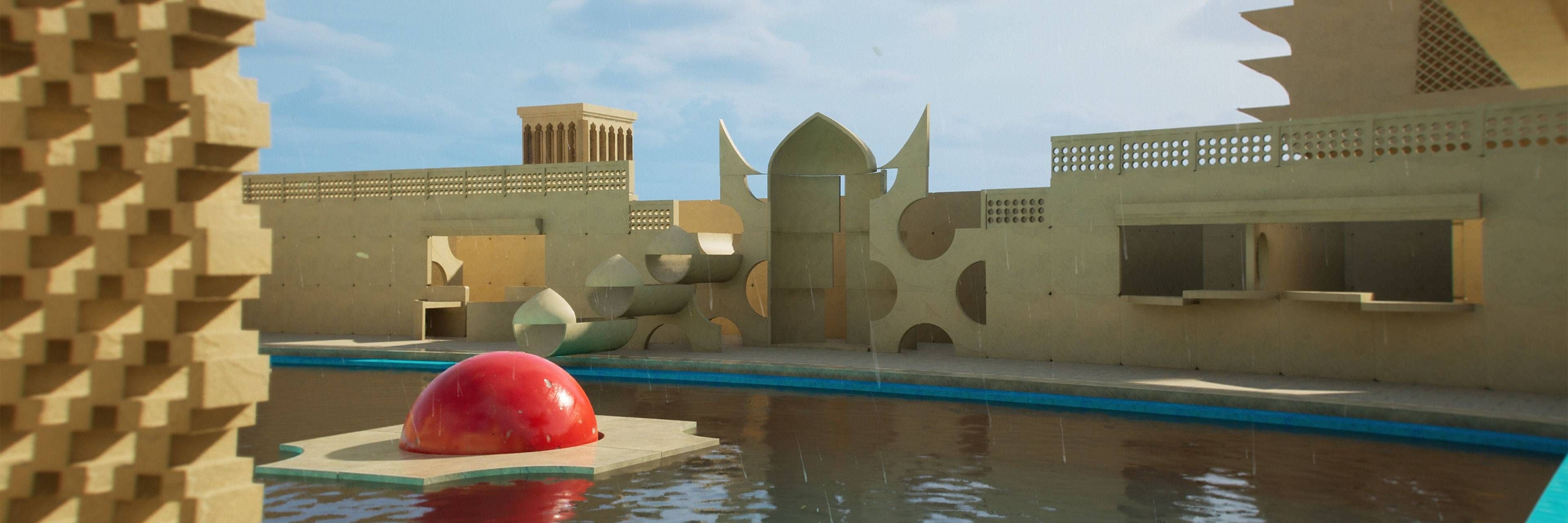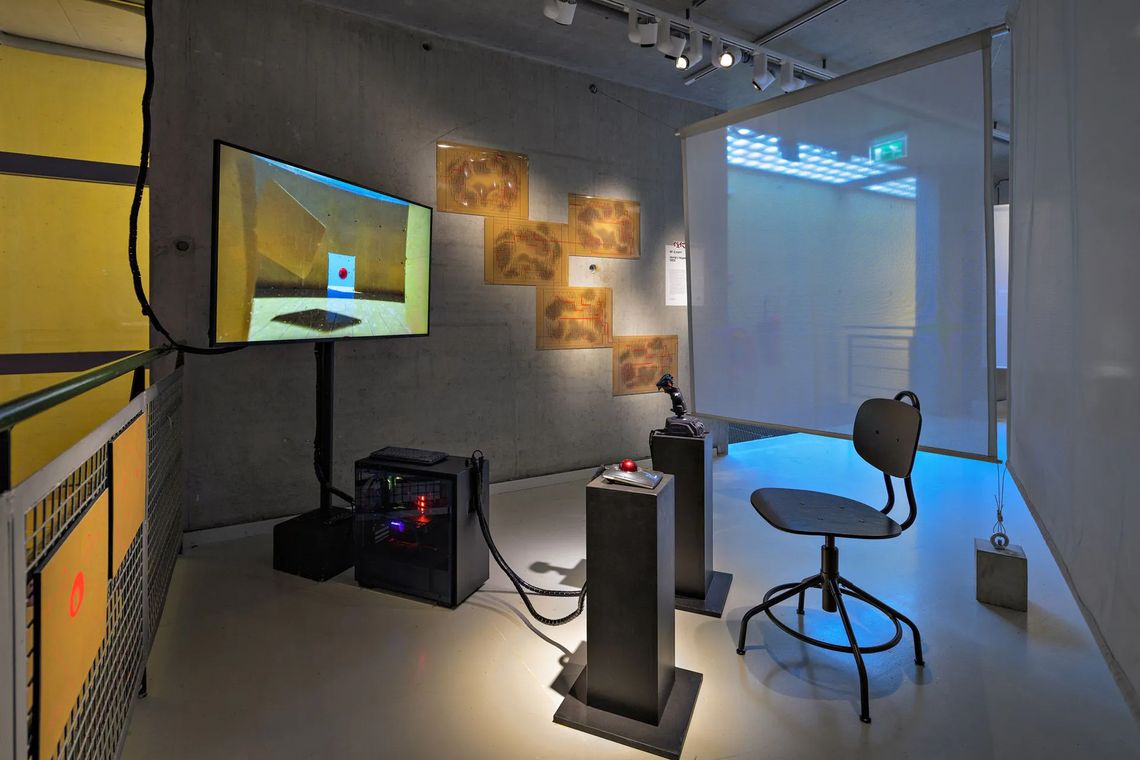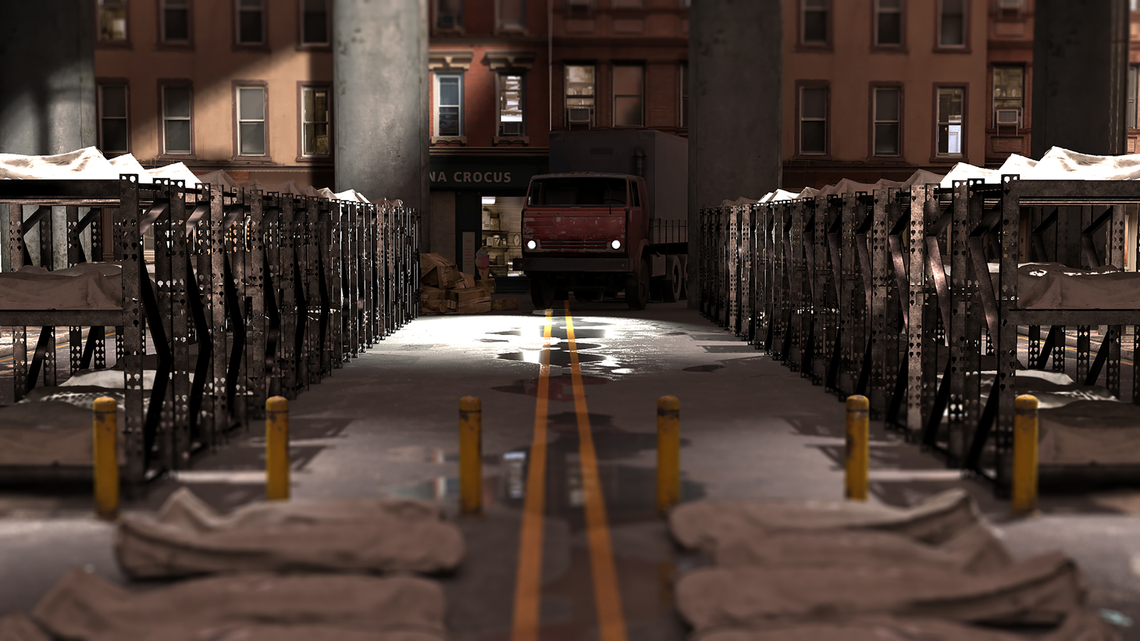
23-11-23
Without locality, an artwork can be anything – a conversation with Ali Eslami
A red ball, approximately the size of an average football, enters what looks like a Persian palace floating in the sky. This image is the opening shot of Homã's Phantom (2023) by Iranian artist Ali Eslami. The interactive simulation is on view at Het Nieuwe Instituut in Rotterdam until the 1st of April 2024 as part of REBOOT - Pioneering Digital Art, an initiative of Nieuwe Instituut and media art platform LI-MA. To discuss this and other work, writer Lena van Tijen spoke to Ali Eslami about the potential and limits of art and technology for world-building, memory and heritage, and fostering uncertainty.
Author Lena van Tijen
Eslami studied civil engineering in Zanjan and lives and works in Amsterdam. From a young age, gaming and the internet played a significant role in his life. The computer is where he encountered a free and imaginative world that contrasted with his physical reality: the socio-political situation in his home country. To react to his lived experience, Eslami began learning his way around the digital world. This effort grew into an art practice comprising many techniques, virtual reality being his most dedicated medium. But, since starting his residency at the Rijksakademie in 2021, Eslami has been shifting more towards contemporary art and film making. As the artist puts it: whatever I do, there's always a computer involved.
Lena van Tijen (LvT): Can you tell me more about Homã's Phantom and its inclusion in REBOOT?
Ali Eslami (AE): The opportunity to show my work at Het Nieuwe Instituut came as a happy coincidence because the concept of the exhibition aligned perfectly with my research, a connection going back to a recent project presented at the Rijksakademie Open Studios 2023, called Line of Sight (2023): an experimental collection of coding poems.
With this work, I wanted to retouch the base of my practice and return to the beginning of my relationship with technology. REBOOT felt like a natural next step in this process, an opportunity to make a work that was in my head for a while and let it enter into conversation with the artworks surrounding it.
With Homã's Phantom, I tried inviting viewers to embrace the uncertainty of a labyrinth to experience the fullness of it. Uncertainty is something that I grew up with. There is a reason we do not have much science fiction in the Middle East. It is hard to think about the next month when there are so many external factors that decide your way of life or even if you live or die.
LvT: As a viewer, you cannot move through the labyrinth. Are you asking your audience to let go of control and embrace uncertainty?
AE: Yes, exactly. To be more precise, the world you are entering is a large house inspired by the architecture of Iranian desert houses. This house centers around a courtyard, and all its rooms connect to each other.
From the outside, it looks very closed off. Once inside, it reveals its own social universe.
You [the viewer] enter the labyrinth as a little red ball navigating automatically along a predefined, complex route. If you leave the ball to it, the path takes around half an hour to complete.
The viewer has no control over the journey but can control its temporality. In the exhibition, you can go back and forth along the route with the trackball of a controller.
LvT: What I found interesting about the work is that you pay homage to Jeffery Shaw, an artist considered a pioneer of digital art, while being perceived as part of a vanguard yourself by being included in this exhibition. How does that feel?
AE: I'm really amazed by Shaw's portfolio. It is really avant-garde, and it is an honor to be in dialogue with his work.
LvT: Points of view, the artwork by Shaw you reference, was partly shaped by the restrictions computer graphics posed at the time. Do you ever reach the limits of technology? What do these limits tell you? Do you try to test them or change them?
AE: My practice involves working with game engines, and when working with games, you have to be aware of your resources. You cannot go beyond the capacity of your tools because otherwise, your work will not run.
When you work with 3D animations, you don't care. You make a work, no matter how complicated, and let it render. With game technology, there are certain limitations, which I find inspiring. You have to understand your medium in order to use it. Sometimes, you reach bottlenecks or other thresholds, and the results are actually quite thought-provoking.
The first time I really noticed this was in 2016 with a work called DeathTolls Experience. The fact that my VR simulation was not working aligned perfectly with my concept. The simulation represents a hyper-realistic world in which you see the exact number of death tolls you hear about on the news by showing bodies in body bags.
One of the examples I used was the Paris attacks of 2015, during which 130 people died. In the simulation, you enter a street with 130 body bags. I made this work so viewers can understand the extent of these numbers.
The last level of the world consisted of a simulation of Syrian war casualties. The number I used was the accumulations of deaths over a period of two years. At that time, this meant 310,000 bodies. When I tried to visualize this number, my computer couldn't handle it. The tragedy was so enormous that even a machine could not comprehend it.

LvT: The setting of Homã's Phantom is both archaic and futuristic. How do you combine past and future in your art?
AE: Referring to the past and to my Iranian roots only recently became a more explicit part of my practice. And Homã's Phantom is the first work I made in this way.
I noticed that in media literacy, there is an alarming lack of voices from the Middle East. For instance, ASCII [American Standard Code for Information Interchange] lacked Arabic and Farsi letters. At the time, in the early years of computers, the computer could only render texts. The text you could type or render was, therefore, limited.
If you talk about text, each word and letter, as a module, then you're building blocks are lacking. In that regard, the building blocks of Middle Eastern culture were absent in early computing and computer art.
My work is about having the agency to play with these ideas, with the history of my culture, our own localities and voices.
Read more about this work on the artists website

Discover more about Ali Eslami on his own website
LvT: Your practice builds around computer games, media art, and computer technology. At the same time, you strongly rely on personal memory and heritage. In what way do personal and technological interact in your art? And when do they intertwine?
AE: I'm part of a diaspora. On the one hand, after five years of living in the Netherlands, I see that the games I used to play as a kid in Iran are the same games my friends here played when they were young. We find a shared memory and a common language in technology.
On the other hand, my subjectivity and locality are also part of my work. That is my understanding of my practice. Without locality, an artwork can be anything in the world of commerce.
LvT: Another important aspect of your art is world-building. What appeals to you in this practice?
AE: What appeals to me is knowing how things function within this world I’m creating and how they work in different layers of operation, from the fundamentals of physics and gravity to its sociopolitical blueprint. I’m making a model of a world with my own understanding of its scopes.
LvT: Do you spend more time in the world you are creating or in the one you are inhabiting?
AE: I try to be present in both.
While worldbuilding might be perceived by some as escapism, as a way of evading situations in real life, this is not how Ali Eslami approaches it. To the artist, who is the first to admit he gets lost in his computer sometimes, the knowledge acquired in one world is equally relevant in the other. In the case of his simulation Homã's Phantom, he tries to teach those who enter his labyrinth the ability to surrender to uncertainty. A valuable skill that, undoubtedly, can be broadly applied.
Info & Tickets REBOOT. Pioneering Digital Art.
The exhibition is on show till April 1st 2024 at Nieuwe Instituut in Rotterdam.
You can read more about the exhibition in a dedicated item on the LI-MA site.
The exhibition is an initiative by LI-MA and Nieuwe Instituut presenting key works of digital art from the period 1960-2000, as well as new works by contemporary makers. Ali Eslami is one of them.
Tickets are available via this LINK.

